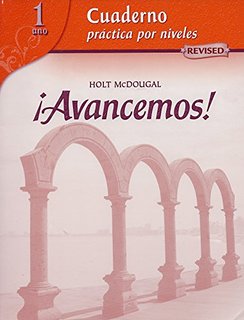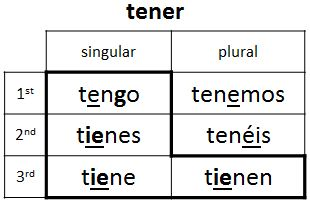
All Solutions
Page 53: Gramatica A
The objective of this exercise is to practise the use of the verb “tener”.
Four sentences are given in this exercise. Each one requires the use of a conjugated form of the verb “tener”. Grammatical subjects are given for each sentence. Refer to these to determine which grammatical person is required to solve the exercise. Consult your manual and your notes to be sure how to conjugate the verb. You may also refer to the following paragraph for further guidance.
Below, you will find a table with the conjugated forms of the verb “tener” in the present tense in the indicative mood.
“Tener” is an irregular verb. Irregularities are marked in bold letters. There are two irregularities concerning this verb:
1. The -g- infix in the first grammatical person in singular. Generally speaking, the -g- infix will only appear in the first person singular in the indicative mood if it applies to an irregular verb. For instance, the verb “ir” is irregular, but its first person is “voy”.
2. The diphtong -ie- in the second and third grammatical persons in singular, and the third grammatical person in plural. A diphtong is a vowel that consists of two vowels, where one is weakened, which leads to the two being pronounced adjacently. They form a single syllable. Take a close look at the diphtongs. Note that stressed syllables are underlined. You will notice that each time the base syllable is stressed and open (thus, tie·nes vs. ten·go), it makes a diphtong. As soon as the stress jumps to a different syllable, the diphtong is lost.
These diphtongs derive from long vowels in Latin. This means that, unfortunately, there is no way to tell which verbs have diphtongs and which do not. You will learn this as time goes by. However, once you are told that the verb does make a diphtong, you will know exactly when to use it and when not. Also, notice how irregularities appear in the 1st, 2nd and 3rd person singular, and the 3rd person plural. Visually, they make up an L-like shape, which is a way of memorising when and where irregularities occur.
2. tienes
3. tienen
4. tengo
The objective of this exercise is to practise Spanish vocabulary.
In this exercise, there are four incomplete sentences. Read them carefully to understand the meaning, as it is going to specify which words to fill the blanks with. You may refer to the below solutions for further guidance.
2. mucho
3. nunca
4. de vez en cuando
The purpose of this exercise is to practise writing in Spanish.
Three images are given in this exercise. Take a look at them and think of two sentences you would write for each. The goal is to say what these people have to do to get a good mark. Use all the vocabulary you have learned by now. Since answers may very depending on your interpretation, only use the below examples as a reference of how your sentences might look like.
1. El chico no es muy trabajador. Para sacar una buena nota en el examen, él tiene que estudiar mucho.
2. La chica es muy organizada. Para sacar una buena nota en el examen, ella tiene que utilizar el ordenador.
3. Los chicos son estudiosos. Para sacar una buena nota en el examen, siempre tienen que hacer la tarea.

